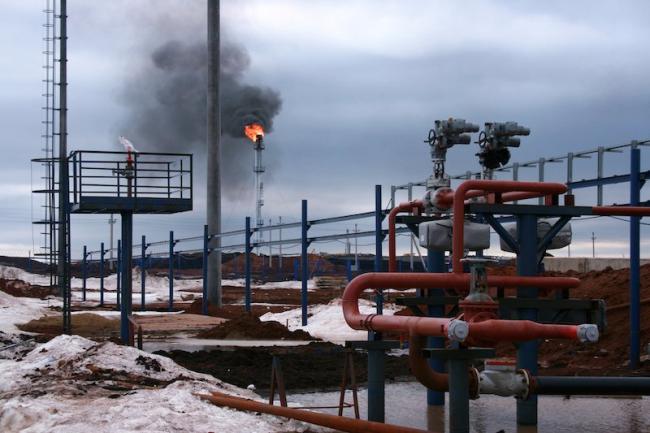Articles Menu

Apr. 11, 2023
This story includes details on the impacts of climate change that may be difficult for some readers. If you are feeling overwhelmed by this crisis situation here is a list of resources on how to cope with fears and feelings about the scope and pace of the climate crisis.
Methane in the atmosphere had its fourth-highest annual increase in 2022, the U.S. National Oceanic and Atmospheric Administration (NOAA) reported last week, part of an overall rise in planet-warming greenhouse gases that the agency called “alarming.”
Though carbon dioxide typically gets more attention for its role in climate change, scientists are particularly concerned about methane because it traps much more heat—about 87 times more than carbon dioxide on a 20-year time scale, The Associated Press reports. That makes methane controls one of the best options for quickly scaling back emissions during a decade when scientists are calling for a 45% reduction in climate pollution.
Methane is emitted from sources including oil and natural gas systems, landfills, and livestock, and has increased particularly quickly since 2020. Scientists say it shows no sign of slowing despite repeat, urgent calls from scientists and policy-makers who say time is running out to meet warming limits in the Paris climate agreement and avoid the most destructive impacts of climate change.
“The observations collected by NOAA scientists in 2022 show that greenhouse gas emissions continue to rise at an alarming pace and will persist in the atmosphere for thousands of years,” NOAA Administrator Rick Spinrad said in a statement accompanying the report. “The time is now to address greenhouse gas pollution and to lower human-caused emissions as we continue to build toward a climate-ready nation.”
Methane rose by 14 parts per billion to 1,911.9 ppb in 2022. It rose slightly faster in 2020 (15.20 ppb) and 2021 (17.75 ppb).
Methane gas leaks from wells and natural gas lines and wafts from manure ponds, decomposing landfills, and directly from livestock.
“We are confident that over half of the methane emissions are coming from human activities like oil and gas extraction, agriculture, waste management, and landfills,” said Benjamin Poulter, NASA research scientist.
Scientists continue to discover that methane emissions from both the fossil industry and the environment are largely underestimated.
“Ruminant animal herds like goats, sheep, and cows in particular are one of the largest human-driven sources of methane,” said Stephen Porder, a professor of ecology and assistant provost for sustainability at Brown University.
The exact amounts of methane that have come from human activity versus natural environments over the past few years is not currently known, but scientists say humans have little control over ecosystems that start emitting more methane due to warming.
“If this rapid rise is wetlands and natural systems responding to climate change, then that’s very frightening because we can’t do much to stop it, said Duke University professor Drew Shindell, a former climate scientist at NASA. “If methane leaks from the fossil fuels sector, then we can make regulations. But we can’t make regulations on what swamps do.”
Scientists are also investigating how the stubborn three-year La Niña pattern across the tropical Pacific could have influenced methane emissions due to higher levels of rainfall in tropical wetlands.
But those atmospheric conditions have also “helped suppress temperatures and dampened the effect of rising greenhouse gas emissions,” The Guardian writes, citing the NOAA release. “Scientists said heat was now rising to the ocean surface, pointing to a potential El Niño pattern in the tropical Pacific later this year that can increase the risk of extreme weather conditions and further challenge global heat records.”
Preliminary data from NOAA show average ocean temperatures at 21.1C since early April, barely exceeding the previous high of 21° in 2016. “The current trajectory looks like it’s headed off the charts, smashing previous records,” said University of New South Wales climate scientist Matthew England.
The prolonged La Niña “was tamping down global mean surface temperatures despite the rise of greenhouse gases in the atmosphere,” agreed NOAA senior research scientist Dr. Mike McPhaden. “Now that it’s over, we are likely seeing the climate change signal coming through loud and clear.”
Brown University’s Porder said shifting away from fossil fuels and reducing the number of ruminant animals being raised are “sure-fire ways to reduce methane in the atmosphere and limit warming,” AP writes. The International Energy Agency estimates that 70% of 2022’s methane emissions could be reduced with existing technology.
The NOAA report said carbon dioxide and nitrous oxide, which carries 285 times the warming impact of CO2, also saw significant growth in 2022.
Carbon dioxide levels rose to 417.06 ppm in 2022 and is now 50% higher than pre-industrial levels, AP writes. Nitrous oxide, which NOAA stated is the third-most significant greenhouse gas emitted by humans, rose to 335.7 ppb, largely due to fertilizers and manure from the expanding agriculture sector.
The main body of this report was produced by The Associated Press and republished by The Canadian Press on April 6, 2023.
[Top photo: 2happy/stockvault]